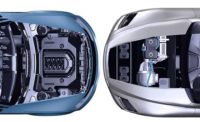Even today, automakers still rely on the subjective evaluations of test engineers when assessing the handling properties of motor vehicles. However, objective evaluation methods using measurable characteristics are growing more important. Objective assessments can reveal even small steps in development progress better than any subjective evaluation could.
Myriad sensors measure both what the driver is doing and how the vehicle is moving. To capture the driver’s actions, sensors measure steering wheel angle and moment, brake pedal travel and force, and accelerator pedal travel. To capture what the car is doing, sensors measure the triaxial forces and moments at the contact area between the road and the tires, as well as wheel speed; wheel position in X, Y and Z; and the toe and camber angles of each wheel. Additionally, the motion parameters of the vehicle’s body (triaxial angles, speeds and accelerations related to the vehicle’s center of gravity) and the deviation from a reference course are determined. Since the sensors cannot be located directly at the center of gravity, coordinate transformations are required.
Measurement Steering Wheel
To assess steering angle, torque and speed, Kistler has developed the Measurement Steering Wheel (MSW). The MSW mounts between the steering wheel and the steering shaft. A central aperture makes mounting easy. To permit universal application, an adapter for connection to the steering shaft gearing can be produced to any specification.
The MSW comes in two models—a 50 newton-meter version for passenger cars and a 250 newton-meter version for trucks.
Steering torque is measured with an integrated strain gauge. Steering angle and speed are measured with a noncontact optical encoder with a resolution of up to 7,200 pulses per rotation.
Pitch and Roll Angle Measurement
Pitch and roll are determined by taking distance measurements at three select points on the vehicle body vis-à-vis the road using laser sensors.
Pitch is the angle between the vehicle’s longitudinal axis and its projection to the road. Roll is defined as the angle between the vehicle’s transversal axis and its
projection to the road. Pitch and roll can be calculated as arc tangent functions from the trigonometric distance relationships.
The laser sensors measure distances via optical triangulation. A visible red laser is projected onto the road and the reflected light is captured by a charge-coupled device (CCD). If the direction of the beam and the distance between the CCD and the light source are known, the distance between the road and the CCD can thus be calculated.
Wheel Vector Sensor
The wheel vector sensor is a five-joint measurement arm with absolute, incremental angle encoders at the joints. The sensor can determine wheel position in the X, Y and Z directions with an accuracy of ±1 millimeter. It can measure camber and toe angle at an accuracy of ±0.1 degree.
Possible uses for the wheel vector sensor include determining axle load shifts while braking, measuring toe and camber angle changes during dynamic vehicle maneuvers, and evaluating the self-steering effect of vehicles. To measure tire characteristics as well, the mounting bracket of a slip angle sensor can be attached coaxially toward the center of the wheel.
Slip Angle Sensor
The slip angle is the angle between the speed vector at the tire contact patch and the wheel plane. A noncontact optical sensor can be used to simultaneously acquire longitudinal and transversal speeds at the wheel and the slip angle. The sensor can accommodate speeds of up to 250 kilometers per hour. Its angle range is ±40 degrees at a resolution of ±0.1 degree.
The sensor works by projecting the structure of the road onto an optical grid and a photo receiver. The brightness differences in the road surface produce a frequency in the photo receiver, which is proportional to the speed in the measurement direction.
Wheel Force Dynamometer
The wheel force dynamometer provides objective information regarding wheel load distribution, wheel ground contact and lateral force. In addition, it can be used as a reliable tool for basic investigations, such as nonuniformity measurements of the tire at high speeds.
Piezoelectric force sensors are at the heart of the dynamometer. These sensors offer a major advantage in that they provide high stiffness without compromising on sensitivity. They don’t age or fatigue, and they exhibit excellent stability and high linearity. Such sensors are characterized by natural frequencies in very high ranges (up to 1 kilohertz).
Depending on the orientation of the polar crystal axes vis-à-vis the effective line of the attacking force, engineers can differentiate between the longitudinal effect, the shear piezoelectric effect and the transversal effect.
When subjected to the impact of an external force, the pairs of quartz plates, commensurate with their sensitive axes, discharge force-proportionate loads. The breakdown of an attacking force into its orthogonal components is directly achieved by the measurement element without any auxiliary mechanical constructions.
Besides the piezoelectric sensors, the dynamometer is equipped with Hall effect sensors to determine wheel turning angle.
Hub Carrier Accelerometer
A triaxial accelerometer mounted to the hub carrier measures the impulse-like accelerations introduced into the wheel location system by unsprung masses at the wheel when driving over uneven road surfaces. The sensor used has a high piezoelectric sensitivity, which is an important prerequisite for miniaturizing the sensor. Because the crystal material exhibits high stiffness, the resonances of the seismic element are high and the sensor can measure large frequency ranges.
Seat Rail Accelerometer
A triaxial capacitative accelerometer can be fitted to the seat rail to measure acceleration in the X, Y and Z axes in a range from ±10 g. Measuring accelerations at the seat rail is a way of evaluating comfort in the vehicle’s interior.
Gyros and GPS
To detect the exact position of a body on the Earth’s surface, the inertial navigation system (INS) has been used for a long time. The INS uses three gyroscope channels to measure rotational speed and three acceleration channels to measure linear acceleration. The accelerometers are also used to keep the system analytically leveled in a steady state, accounting for the orientation of the Earth’s gravity. The gyros calculate the angles in three dimensions at any instant under motion.
The system offers high bandwidth, low data latency, translation and rotation data, and relative position.
The main disadvantage with the INS is that calculations of position and velocity can drift over time. To overcome this problem, differential global positioning system (GPS) technology is used to instantly correct drift errors. This yields positional information that is accurate to the centimeter. Precise speed and time measurements can also be derived from DGPS signals.
The gyro system can determine angle speeds, dynamic course and position angles, and the float angle. It also obtains precise acceleration, speed and position data.
Tire Temperature Measurement
The temperature inside a tire is one of the most reliable indicators of tire load and stress. In addition, tracking internal tire temperature over time can provide information about the service life of the tire. The goal is to optimize the tire design and fine-tune vehicle performance.
Tire temperature is measured in the tire’s tread and shoulder using Pt-100 resistance sensors.
Synchronous Data Acquisition
Synchronicity of the sensor data is particularly important for vehicle dynamics testing. Up to now, the data obtained by different sensors and systems could only be correlated with each other with major error tolerances and a considerable investment of time.
Now, Dewetron has introduced powerful data acquisition units with a precise, quartz-stabilized cycle rate of 80 megahertz and a slope accuracy of 2 nanoseconds. The system synchronizes measurement data from a variety of sources and provides them with a real-time stamp. All incoming data and their time-related information are filed in a central data base.
Analog signals, such as acceleration, temperature, strain, pressure and force, can be directly connected to the instrument, as well as GPS, counters, encoders and four video cameras.
In addition, the internal system cycle can be coherently coupled with an external cycle signal to make absolutely synchronous measurements using the positioning signal of a GPS satellite, for example, which is already being used in other applications.
With Dewetron’s technology, analog and digital information are read out in the same cycle. The synchronization with the system cycle also applies to CAN bus, local area network and other asynchronous interfaces and bus systems.
Braking From a Straight Line
Braking is a major focus of vehicle dynamics testing. Vehicular motion when braking from a straight line provides information on the deceleration capability of a vehicle, as well as vehicle stability during hard stops. The goal is to achieve the shortest possible braking distance while optimizing comfort and responsiveness.
For accurate testing, the road’s grip properties should be as consistent as possible across the entire braking distance. To test the antilock braking system, the vehicle should be tested roads with different grip properties.
The primary measurement parameters for braking tests include:
- Brake pressures at various points of the system.
- Brake pedal force.
- Braking distance.
- Driving speed.
- Longitudinal deceleration.
- Pitch angle (to evaluate the anti-dive effect achieved by the design).
- The driving maneuver is performed on an even road from a starting speed of 100 kilometers per hour and constant brake decelerations (2, 4 and 6 meters per second squared). The ABS is turned off.
- The following parameters are used to evaluate vehicle stability:
- Steering wheel angle.
- Yaw speed.
- Yaw acceleration.
- Lateral speed or float angle.
- Lateral acceleration.
- Deviation from course.
- Wheel forces in X, Y and Z direction.
Lane Change Test
The lane change test is a closed-loop test in which the vehicle operator has to drive through a standardized cone-lined lane in as short a time as possible without hitting the cones. The tests are conducted with and without electronic stability control.
- The primary parameters for this test include:
- Driving speed, vehicle longitudinal and lateral speed.
- Steering wheel turning angle and steering wheel torque.
- Wheel forces, moments and speeds.
- Toe and camber angle, and wheel motion in X, Y and Z.
- Vehicle float angle (leveled and related to road surface).
- Slip angle on vehicle wheel.
- Pitch, roll and yaw angle (leveled and vehicle-related).
- Longitudinal, lateral and yaw acceleration (leveled and vehicle-related).






